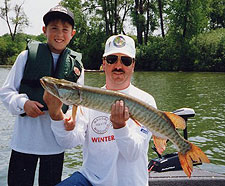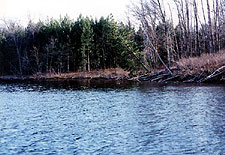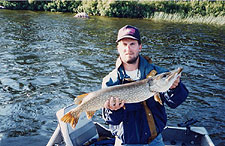|
When it comes to fishing minnow baits, the word "twitching" is often associated with it. Yes, you can cast out a crank bait or minnow bait and just simply reel them back in with a straight retrieve. And yes, you can and will catch fish. But when adding a twitching action to this already proven bait, you can make your lure presentation much more appealing to muskies, pike and big bass! Twitching is nothing new to the sport of musky fishing. Musky guides and tournament anglers have been using this lure presentation for years to consistently put fish in there boat for there guide clients or to win tournaments. However, there are a few questions that need to be answered before you get started. |
 A happy guide client and his son shows off a nice musky that was triggered into striking with a twitched 5 inch perch color Slammer. |
What makes a crankbait a "twitch" bait?
Slammers and
minnow baits in general are made with a flat, high profile side that creates
flash and a tremendous amount of water movement when coming through the water.
There shallow running action combined with being buoyant makes then ideal
for twitching!
Twitching the 7 inch Slammer Deep Diver is often over looked by some anglers
as a crankbait presentation. Deep running cranks are a great tool for triggering
strike's when muskies move into deeper cover. The 7 inch Slammer Deep Diver
has a wide head shake with lots of vibration and when stopped in the water,
it floats backwards out of cover. When twitching, a darting left to right
action can be made with the lure.
Do you need any "special" equipment for twitching?
Standard musky
sized tackle should be used for twitching. Rod length can vary from fisherman
to fisherman, but the longer rod seems to be favored by most. St. Croix Rods
makes a excellent line of quality Musky rods to choose from. The 7 foot model
PM70MHF or the 7 1/2 foot PM76MHF is a popular choice with the serious twitcher.
For more models of rods check out St. Croix Rods on the web at http://www.stcroixrods.com
The standard Abu Garcia 6500C or 5500C works great for a reel. My personal
preference for line has been 50 pound Courtland Spectron. It's low stretch
makes it very sensitive. This is important when working your bait through
cover when you need to feel your bait ticking weeds, wood or rock.
A quality 7 stranded leader around 12 inch's long with a ball bearing swivel
on one end and a coast lock snap on the other and your all set!
How do I "twitch"?
There is really
no wrong way to twitch a crankbait. Simply cast out and start your retrieve
by reeling and holding the rod down in a 5 o'clock position. Through out the
retrieve snap you rod downward while continually reeling. This snapping action
should be varied from a long pull to short snap's trying to create an erratic
movement with the bait. The short hard snaps can often force the bait to swing
sideways or back and forth giving it a zig zag motion. During mid retrieve
and at boat side I like to do what is called a "dead rise" with
the bait. On the mid point of the retrieve, stop reeling to allow the bait
to float up toward the surface. Try to get the bait float up with in a inch
or two of the surface and then start the retrieve back up with a hard long
twitch. Often, this hard twitch will cause a small boil on the surface of
the water that will create some commotion and can get a muskies attention.
The second dead rise should be done in the same manner, doing it a few feet
from the boat, then reel the lure straight back and finish off with a large
figure eight. These longer pauses will often trigger a following fish into
striking. This "dead rise" trick should not be overlooked and should
be done on every cast.
On larger Slammers or the 7 inch Slammer Deep Diver, longer pulls or sweeping
the rod downward and to the side can be used to give the lure a stopping and
starting action. Changing the rod movements and speed of retrieve is what
can make all the difference in the world some days, so like I said earlier,
there is no wrong way to twitch.
Where do I "twitch" a Slammer?
Through out
the season the muskies will change location in order to find food and to fill
there need from day to day. Finding the muskies location is first and foremost
in catching fish! You can't catch fish if there is none to be caught. Typically,
spring time and fall, when the muskies can be found using shallow water structure
is when twitching Slammers can a hot tactic. This past spring, ALL of the
fish that where caught from my boat came on twitching baits. We were throwing
everything at them, and they would follow the other lure presentation, they
were eating the twitched lures.
In the early season start by looking for warm water with some good weed growth.
Rock's and wood added to these areas make them all the better. Do not be afraid
to fish shallow. On some days if the lure was not being cast with in a foot
or two of the shore line you might as well have been casting in the middle
of the parking lot at the boat launch. These post spawn fish (especially the
males) will remain in and around there spawning areas for a few weeks after
spawning is complete. This is a prime location to fish! As the season progresses
and the weed start to come up, start working out from these areas over the
adjoining weed flats. As you get into a late spring time and a early summer
pattern the weeds will have developed a distinct deep weed edge. The fish
will often work this deeper weed line in search for food. You should begin
your day here looking for active fish. Holding your boat on or slightly off
of the weed line and twitching a 7 inch Slammer Deep Diver parallel with the
deep weed edge while your fishing partner is casting over the weed tops and
twitching a smaller Slammer minnow bait is a fantastic way to locate active
fish.
| Again in the fall the fish will be associated with this deeper weed edge when they put there feed bags on for trying to add body fat for the up and coming winter. Working this type of area through out the day with twitch baits is a yearly pattern that has proven itself time and time again. Twitching the 7 or 8 inch Slammer or the 7 inch Slammer Deep Diver over and along a deep weed line that is adjacent to some deep water with a good wind blowing across it can be deadly. Steep breaking shorelines with downed timber along it is an ideal feeding location for fall musky. |  Finding these steep shorelines with downed timber like this one lead to a first place tournament finish for the author that is described in the article. |
A few years back
while fishing a tournament in northern Wisconsin and huge cold front had came
through the Friday night before the tournament. We woke up Saturday morning
to find a boat covered with frost and a thermometer that said 28 degrees.
Clear skies and ultra old weather was not what I had hoped for that morning!
At the start of the day we took off and headed to a steep breaking shore line
with plenty of downed timber along it and that was adjacent to some of the
deeper water in the lake. I started the day be twitching. With in the first
15 minuets I had a fish come up and just plow the bait on the boat side dead
rise. I instantly started using longer pauses in between jerks with more hang
time and adding more of the dead rise's to my retrieve. Soon came the first
of three muskies I had caught for our boat in that tournament.
With only 7 fish caught in two days of fishing between 100 teams, I had 3
of the 7. We had won first place, big fish on Saturday and big fish for the
tournament! On a weekend that I thought would turn out bad, it turned out
to be one heck of a weekend. The one thing that saved us was changing our
twitching to longer pulls with a much longer pause. That large flash from
the lures flat side's and vibration was what got the muskies attention and
the increased dead rise's through out the retrieve triggered the strike. The
three fish I had caught and two more that I had lost all hit the lure when
it was suspending motionless during the dead rise.
|
This sounds to good to be true! Twitching
Slammers is a great way to trigger strikes, but being versatile through
out the year is what will consistently put fish in the boat day in and
day out. Adding a twitched Slammer to your bag of tricks and using them
when the fish want a twitched bait will add up to more muskies, pike
and big bass for you at the end of the year. This is something that
can be guaranteed! |
 Muskies aren't the only fish that like twitch baits! This Northern Pike wastwitched up using a 6 inch Golden Shiner color Slammer by the author's fishing partner and Slammer "Pro Team" member Jason Smith of www.muskiefirst.com |